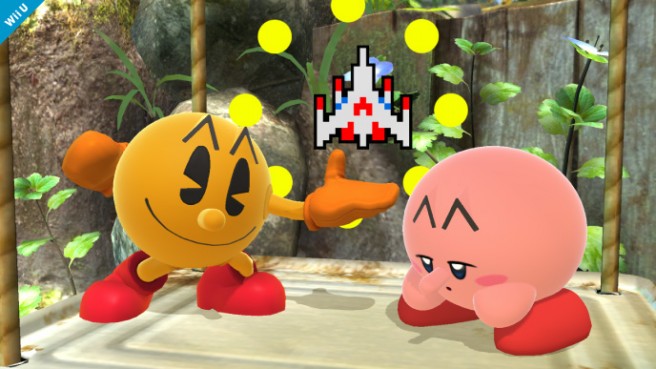Masahiro Sakurai on Pac-Man’s inclusion in the new Smash Bros.
Posted on August 3, 2014 by Brian(@NE_Brian) in 3DS, News, Wii U
NeoGAF’s “Masked Man” has translated one of Masahiro Sakurai’s older Famitsu columns in which he discusses Pac-Man’s inclusion in the new Super Smash Bros. for Wii U and 3DS. He talks about how Miyamoto originally approached him with the idea when developing Brawl, Pac-Man’s reveal at E3, the character’s design, and much more.
You’ll find the full translation below:
Back when I was developing Super Smash Bros. Brawl, Shigeru Miyamoto asked me, “What do you think about Pac-Man as a guest character?” “There’s no way!”, I thought to myself as I envisioned that mascot oh-so reminiscent of a pizza missing a slice. I didn’t say it out loud, of course.
But here we are, eight years later, and everything is complete. You never know what’s going to happen in this crazy world. Actually, perhaps I’d just better say nothing at all–yes, that’s a good idea.
In any case, at the E3 2014 roundtable, I announced Pac-Man’s inclusion as a playable character in Super Smash Bros. for 3DS and Wii U. The event itself was restricted to the media and held in a rather small venue, but as soon as I revealed Pac-Man, the room was immediately filled with deafening cheers and applause.
I decided to use the old-school Pac-Man design you often see in illustrations–a sphere with arms and legs stuck on–and not the more recent white-eyed look. Of course, Pac-Man also reverts to his familiar spherical shape for certain attacks.
Pac-Man utilizes a number of elements from the games he’s appeared in, like the fire hydrant from “Pac-Land” and the ghosts and bonus fruit from the original “Pac-Man”. You can charge his Bonus Fruit attack to cycle through projectiles that all possess different trajectories and other unique characteristics.
I’ve also included a Pac-Maze stage in the 3DS version of the game. If you collect 100 dots, a player-exclusive Power Pellet appears that powers up your character when consumed. The key thing to note is that the ghosts turn frightened when you eat the Power Pellet, but they don’t change on the opponents’ screens. This is just one of the many designs I’ve implemented that is only possible on the 3DS where each player has his or her own screen.
But I suppose Pac-Man’s already had enough of an introduction. I’d like to talk more about the intention behind my game design.
Since I am creating the new Smash Bros. in cooperation with Bandai-Namco Games, it makes sense to include one of their characters, and Pac-Man is perhaps Namco’s most iconic character, so Pac-Man should join the fray. It’s a pretty logical train of thought for anyone who has been playing games for many years.
However, simply thinking about including a character in the game and the act actually crafting the character and making them work are two entirely different things. It’s quite difficult for me because most players only think about whether a character is in the game and fail to consider the difficulties of bringing that character to life.
How should I bring out the character’s personality? How should I make them move? Can I devise a consistent, comprehensive style for them? What techniques can I come up with to help them stand out from the other fighters? Moreover, do those techniques fit the character and their original game? And, above all, can I make the character fun to play?
If I just slap together a moveset, that character wouldn’t be very enjoyable. Conversely, on a big project like this one, there isn’t a lot of time allotted for trial and error when creating characters.
I decided on nearly all the types of newcomers I wanted to include at the time of the game’s conception. Pac-Man was of course also present in the game’s incipient stages.
During the initial design process, I thought long and hard about a number of things, but the most important thing was that I developed an idea of Smash in my mind and made sure not to stray too far from that concept.
Should complications arise during development, I take the ideas I came up with during the initial planning stages, compare them with what is feasible at present, and endeavor to come up with the best possible solution. This doesn’t mean taking the middle road with a simple compromise; I come up with a design that fits the current situation while doing my best to preserve the original concept I had in mind. I’ve found that this is an effective means of problem solving for me–and one that might also be applicable for many other kinds of professions.
